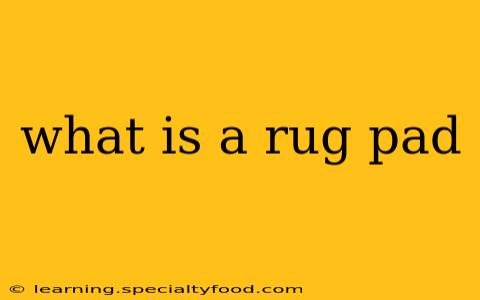A rug pad, also known as a rug underlay, is a cushioning layer placed beneath your area rug. It's much more than just a simple piece of padding; it's a crucial element in extending the life of your rug, enhancing its appearance, and improving your overall comfort. Think of it as the unsung hero of your floor coverings, working behind the scenes to provide numerous benefits you might not even realize.
What are the Benefits of Using a Rug Pad?
Rug pads offer a surprising array of advantages, impacting both the longevity of your rug and the comfort of your space. Here's a breakdown of the key benefits:
-
Prolongs Rug Life: A rug pad acts as a buffer, absorbing shock and preventing the constant friction between the rug fibers and the floor. This significantly reduces wear and tear, keeping your rug looking newer for longer. It prevents the rug from matting down, fading prematurely, and developing wrinkles or creases.
-
Enhances Comfort: Walking on a rug with a pad underneath is noticeably softer and more comfortable. The added cushioning makes a significant difference, especially in high-traffic areas.
-
Increases Rug Stability: Rug pads prevent your rug from slipping and sliding, eliminating tripping hazards and keeping your rug securely in place. This is especially important for rugs on hard floors like hardwood, tile, or laminate.
-
Improves Sound Absorption: Rug pads help to dampen sound, reducing noise from foot traffic and making your space quieter and more peaceful. This is particularly beneficial in apartments or homes with hardwood floors.
-
Protects Your Floors: By preventing direct contact between your rug and the floor, a rug pad also protects your flooring from scratches and potential damage. This is especially important for delicate floors like hardwood or polished concrete.
What are the Different Types of Rug Pads?
Several types of rug pads cater to various needs and budgets:
-
Felt Pads: These are the most basic and affordable option, offering decent cushioning and some anti-slip properties. However, they are generally thinner and less durable than other options.
-
Foam Pads: Foam pads provide excellent cushioning and are relatively inexpensive. They come in various thicknesses and densities, offering varying levels of support.
-
Memory Foam Pads: These offer superior cushioning and comfort, conforming to the shape of your rug and providing a luxurious feel underfoot. They tend to be more expensive than other options.
-
Rubber Pads: Rubber pads are known for their excellent grip and anti-slip properties, making them ideal for rugs on hard floors or in high-traffic areas.
-
Combination Pads: These pads often combine materials like felt and foam or rubber and foam to offer the best of both worlds, providing cushioning, support, and grip.
What Size Rug Pad Should I Buy?
To ensure optimal performance, it's crucial to choose the right size rug pad. The general rule is to buy a rug pad that is slightly smaller than your rug. This prevents the pad from bunching up at the edges and makes it easier to manage.
How Do I Clean a Rug Pad?
Cleaning methods vary depending on the type of rug pad. Always check the manufacturer's instructions for specific cleaning recommendations. Some pads can be vacuumed, while others may require spot cleaning or professional cleaning.
How Often Should I Replace My Rug Pad?
The lifespan of a rug pad depends on its quality and the amount of foot traffic it receives. Generally, you should expect to replace your rug pad every 2-3 years, or sooner if it shows significant wear and tear.
Choosing the right rug pad is an investment in the longevity and enjoyment of your rugs. By considering the factors discussed above, you can select the ideal pad to protect your investment and enhance your living space.
